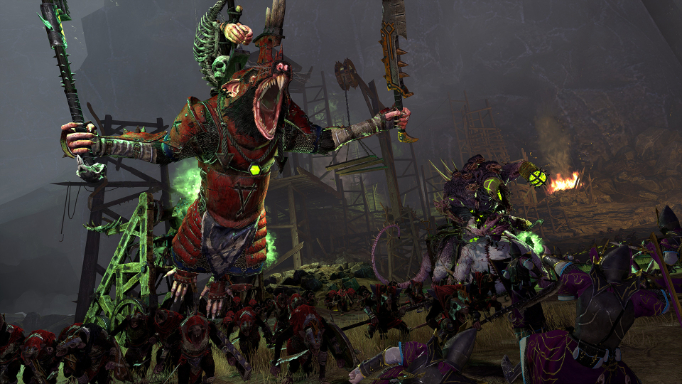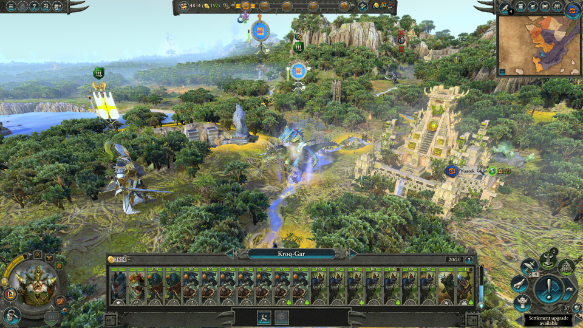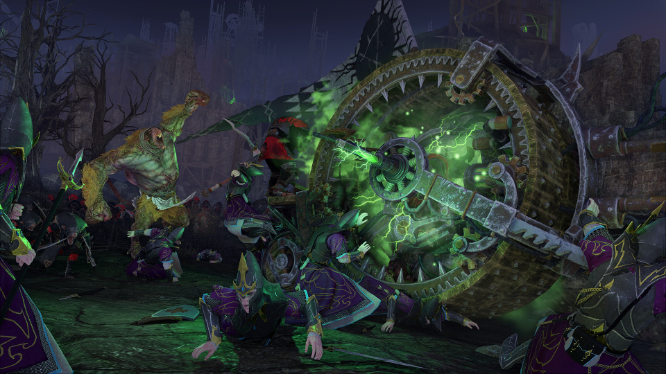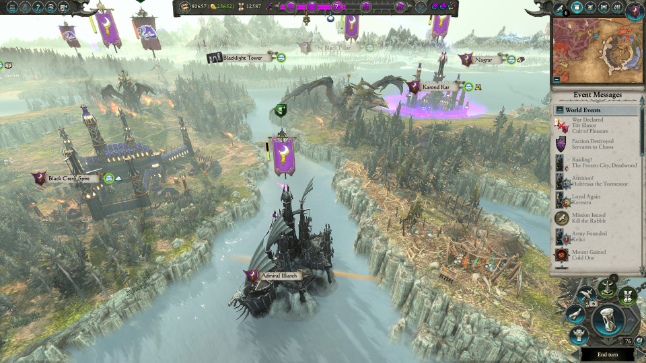Years ago, when the idea of a sequel was brought up it meant something very specific. Often expected to be a huge leap forward in terms of gameplay, graphics and presentation, sequels were well-hypes transitions to a new era of a game. Between them, we had expansion packs; £20-ish releases which added new campaigns, stories, worlds and features to the existing game.
When Total War: Warhammer was released around a year and a half ago, expansions were expected, and we received them As DLC packs. Whilst some would consider them expensive, I enjoyed my time with some of the less known Warhammer races and welcomed their inclusion.
Now we come to somewhat of a crossroads; the first sequel to TW:W, aptly named Total War: Warhammer 2. The question is this; does it live up to its price tag and the title of sequel, or is it just a glorified DLC pack?

Just as a refresher on the franchise; the Total War series combines turn-based strategy and empire management campaigns (similar to the Civ games,) with real-time tactical battle control. Set in various historical settings, from ancient Rome to the Napoleonic wars, the games are well known for quality tactical combat and a good use of setting and source material. The gameplay of the series requires a lot of military strategy and planning, with huge units of soldiers marching across battlefields; flanking, charging, knowing when NOT to charge, marching and breaking morale. Rather than focusing of single-unit micro and resource management, the tactical battles are more about planning and positioning using the troops you gather in the campaign to fight enemies.
At its heart, Total War: Warhammer took the large-scale battles and fantasy setting of the tabletop game and slammed it into the tried, tested and beautifully refined framework that Total War supplied, including magical creatures and monstrous enemies to slaughter their way across the Old World.

Total War: Warhammer II takes that combination and expands upon it. The original shipped with 4 factions; The Empire, Dwarves, Vampire Counts and Greenskins. TW:W2 matches this number by adding the Lizardmen, High Elves, Skaven and Dark Elves to the roster, and challenges the player against enemies new and old across a new world.
Gameplay itself is almost identical to the first game, with a couple of unique twists. Whilst the original’s campaigns usually revolved around a generally story-less conquest of the world as you expanded your empire, TW:W2 instead tasks you with taking control of the great Vortex, which holds back the flow of Chaos into the world. Dependant on the faction you choose, your aim will either be to reinforce or destroy it, but either way you must capture and control various locations to conduct powerful rituals – aside from that it’s just the standard Total War fare.
Whilst not much is new, there are a few bits. Your factions can now occupy any settlement; a feature that really should have been in the first game. Granted, Lizardmen won’t do particularly well if they colonise an ice-covered castle and will take some pretty serious penalties, but it’s possible. It’s also possible to cross the sea now and search for treasure; which makes sense, given the emphasis on gathering relics and commencing rituals. Another important tweak is a huge expansion of the tutorial, which now much more effectively teaches new players how the access the game. Granted, it’s still damn difficult and a little opaque if you’re new to the style of play, but it’s a big improvement.

The main additions are the huge new map, made up of tropical islands, and the four races…
The Lizardmen – The Aztec-ian lizardmen ironically play as a turtling race; expanding slowly but gaining huge bonuses from their tech trees and buildings. In battle they send out slow-but-tough Saurus units and faster, but weaker, Skinks. Alongside these infantry units they have Pterodactyl-riding skinks who drop artillery, Cold-One riders (who are literally a dinosaur riding a dinosaur) and a variety of monstrous Jurassic creatures to tear your enemies a new one with. The biggest negative with the Lizardmen is their tendency to go berserk when they lose Morale, which can often lead to the loss of whole units.
The High Elves – Possibly the most stuck-up race in Warhammer fantasy, the High Elves have a balanced roster of infantry, magical options and dragon units, which allow them a great deal of flexibility. Whilst they are a more shooty army than the Lizards, they are a reliable and responsive option who have strong melee and mounted options. They play the most traditionally in the overworld, requiring influence in order to cast their rituals.
The Skaven – The Rat-men are a very unique race to play as; partially because their settlements appear as ruins to the un-initiated. Malevolent and self-serving, their armies consist of a huge number of meat-shield units backed up by powerful Rat-Ogres and twisted machines. Their grand campaign plays differently to others, as they require food in order to survive and grow. Food can be gathered through buildings, sacked settlements and from captured enemies. (YUK.) As a faction they must also remain constantly on the move, as their corruption is a detriment to their own forces. A shout goes out to the Warpfire thrower; an infantry unit which spreads warpstone fire on the battlefield; melting friend and foe alike with a green flame.
The Dark Elves – Basically an off-shoot faction of the High Elves, these have been corrupted by Chaotic forces and serve only themselves. Slavers, murderers and god-knows what else; these aren’t a pleasant faction. Serving Khaine, the bloody handed god, the Dark Elves live for pain and destruction. With a good mix of melee, ranged and monstrous units (including cold-ones and hydra), they are a fearful force on the battlefield. Features unique to them are the Black Ark; a naval unit that doubles as a floating settlement, Slaves; which generate income and can be sacrificed to perform rites but reduce public order, and Murderous Prowess; which gives your entire army a bonus once enough enemies have been slain.

As you can see, there is a good variety of factions, and what’s more they play very differently in comparison to those from the original game. It’s fab to see the inclusion of these more obscure races as base game factions, though I would have liked to have seen the Tomb Kings included; though undoubtedly they’ll arrive as DLC or in Total War: Warhammer 3.
The big problem with this game is the fact it’s a game in itself. Yes, you get a new campaign and four races. Yes, that’s worth paying for, but this is not a true sequel. The presentation is almost identical, with no real overhaul or graphical improvements. For all intents and purposes, it’s the same thing, with some seriously needed quality of life upgrades and a couple of extra mechanics. This would have served better as a £30 expansion; though I do understand the desire to more easily acquire new players with a single purchase.

My other big criticism comes from the continuation of Creative Assembly’s DLC practices. Yes, they haven’t released any major DLC yet for this game, but the DLC purchased for the original carries across into the free Mortal Empires campaign, which brings all races together. Despite owning both games, if you want the full experience of TW:W2 you would be expected to pay £60 extra for the original’s DLC to access all units. Whilst I applaud them for bringing the Mortal Empires Campaign into the game free of charge, I can’t understand why an “all previous DLC” pack at a discount hasn’t been made an option.
That’s not to mention the £1.99 “Blood for the Blood God II” DLC that they’ve brought out already for number 2; “This pack adds blood and gore effects to Total War: WARHAMMER II including dynamic blood spurts, bloodstains, decapitation, dismemberment, explosive ‘gibbing’ and more.” Excuse me if I’m wrong, but in the dark and gritty, violent world of Warhammer, surely that should come as standard?
All in all though, Total War: Warhammer 2 is a solid continuation on the foundations set by it’s predecessor. I don’t feel it’s enough of a technical improvement to justify the numerical release, as many of the quality of life advances could, and perhaps should have been released as a patch for the original, but it is a solid improvement on the formula none-the-less. If you enjoyed the first you’ll enjoy the second, and it’s definitely a better game overall; just don’t expect any ground-breaking changes.
Also, the name is still stupid. Just call it Total Warhammer II.








You must be logged in to post a comment.